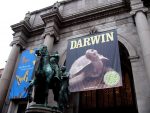We have a new Tangled Bank at Get Busy Livin’ or Get Busy Bloggin’.
We have a new Tangled Bank at Get Busy Livin’ or Get Busy Bloggin’.
Creationists are fond of the “it can’t happen” argument: they like to point to things like the complexity of the eye or intricate cell lineages and invent bogus rules like “irreducible complexity” so they can claim evolution is impossible. In particular, it’s easy for them to take any single organism in isolation and go oooh, aaah over its elaborate detail, and then segue into the argument from personal incredulity.
Last night, I had to read this book RPM mentioned. It’s not very long—about 100 pages, counting a preface, an epilogue, and an afterward, and it has lots of pictures—but be warned: it’s very inside baseball.
The book is Won for All: How the Drosophila Genome Was Sequenced(amzn/b&n/abe/pwll) by Michael Ashburner, and its subject is the rush to sequence the Drosophila genome in 1998-1999. It’s a rather strange twist on what I expected, though. While the subtitle says “How the Drosophila Genome Was Sequenced,” there is almost no science at all in the body of the book; instead, it’s all about the people and the politics, with Ashburner flitting about from place to place, yelling at people and eating sushi. It’s phenomenally entertaining.

Let me tell you about this Achilles tendinitis I’ve got.
My first couple of steps in the morning are flaming agony. After working it and gingerly stretching for a while, it subsides to a dull ache, and I’m good for about a half hour of cautious hobbling. After that, though, the pain builds and builds, until it’s like slamming my heel down on a white hot knife.
I’m not saying this because I’m fishing for sympathy. I spent over an hour and a half today limping through the Darwin exhibit at the AMNH. The pain I suffered through tells you a) how stupid I am to overdo it (I’m paying for it now, I tell you) and b) how good that exhibit is.
It follows the development of Darwin’s thought and demonstrates the evidence that led to his conclusions. It is completely uncompromising. It makes a few nods to the modern evidence at the end, and does mention the creationist objections briefly, as the nonsense they are…but it’s amazing how solidly the case can be made for evolution using just the 19th century data.
And then, or course, there are the artifacts. Darwin’s microscope. Annie’s box(amzn/b&n/abe/pwll). Bits of his notebooks. Darwin’s walking stick. It was glorious stuff.
I strongly recommend it. Even if the exhibit is also full of psychopathic badgers with acid-dripping claws ripping at your ankles. It’s really worth it.
Since Evolgen recognizes the importance of evo-devo, I’ll return the favor: bioinformatics is going to be critical to the evo-devo research program, which to date has emphasized the “devo” part with much work on model systems, but is going to put increasing demands on comparative molecular information from genomics and bioinformatics to fulfill the promise of the “evo” part. I’m sitting on a plane flying east, and to pass the time I’ve been reading a very nice review of the concept of modularity in evo-devo by Paula Mabee (also a fish developmental biologist, and also working in a small college in a small town in the midwest…but rather deservedly better known than yours truly). In addition to summarizing the importance of the concept of modularity to evolution and development, the paper also does something I always appreciate: it summarizes the key questions that the modern evo-devo research program is working to answer.
The Art of Science exhibition has many lovely pictures in the galleries, but I think my favorite is this image of Nodal expression in zebrafish.

After writing about the dilution of those “dangerous” kids’ chemistry sets, I find that Nature has just published a news article wondering how dangerous chemistry actually is.
Fellow scienceblogger Evolgen has seen the light—evo-devo is wonderful. He’s attending a meeting and listening to some of the bigwigs in the field talk about their work, in particular some research on the evolution of gene regulation. While noting that this is clearly important stuff, he also mentions some of the bickering going on about the relative importance of changes in cis regulatory elements (CREs) vs. trans acting elements, transcription factors. I’ve got a longer write-up of the subject, but if you don’t want to read all of that, the issue is about where the cool stuff in the evolution of morphology is going on. Transcription factors are gene products that bind to regulatory regions of other genes, and change their pattern of expression. The things they bind to are the CREs, which are non-coding regions of DNA associated with particular genes.

One of the most evocative creatures of the Cambrian is Anomalocaris, an arthropod with a pair of prominent, articulated appendages at the front of its head. Those things are called great appendages, and they were thought to be unique to certain groups of arthropods that are now extinct. A while back, I reported on a study of pycnogonids, the sea spiders, that appeared to show that that might not be the case: on the basis of neural organization and innervation, that study showed that the way pycnogonid chelifores (a pair of large, fang-like structures at the front of the head) were innervated suggested that they were homologous to great appendages. I thought that was pretty darned cool; a relic of a grand Cambrian clade was swimming around in our modern oceans.
However, a new report by Jager et al. suggests that that interpretation may be flawed, and that sea spider chelifores are actually homologous to the chelicerae of spiders.
